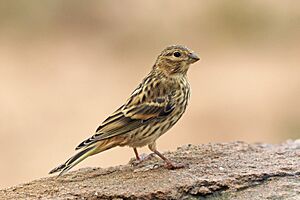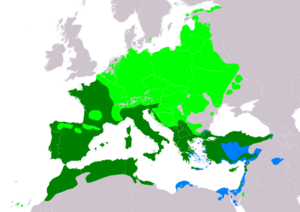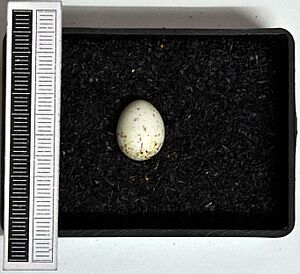European serin facts for kids
Quick facts for kids European serin |
|
|---|---|
 |
|
| Male | |
 |
|
| Female both Souss-Massa National Park, Morocco |
|
| Conservation status | |
| Scientific classification | |
| Genus: |
Serinus
|
| Species: |
serinus
|
 |
|
| Range of S. serinus Breeding Resident Non-breeding | |
| Synonyms | |
|
Fringilla serinus Linnaeus, 1766 |
|
The European serin is a tiny bird, also known simply as the serin. It belongs to the finch family, which includes birds like the Atlantic canary. This little bird mainly eats buds and seeds.
Contents
About the Serin's Name
The European serin got its scientific name from Carl Linnaeus. He was a famous scientist who named many living things. In 1766, he called this bird Fringilla serinus.
The word serinus comes from the French word "serin." This French word means "canary." It might even come from the Latin word citrinus, which means "lemon-coloured." This makes sense because of the bird's yellow feathers!
What Does the Serin Look Like?
The European serin is a small bird. It has a short tail and is about 11 to 12 centimeters long. Its back feathers are greyish-green with dark streaks. It has a bright yellow patch on its lower back, called the rump.
Its chest is yellow, and its belly is white. Both of these areas have many dark streaks. Male serins are usually brighter. They have a more vibrant yellow face and chest. They also have yellow stripes on their wings and yellow on the sides of their tail.
Serin's Song
This bird has a very special song. It sounds like a buzzing trill. If you visit Mediterranean countries, you will often hear this unique sound.
Where Do Serins Live?
European serins live and breed across southern and central Europe. They also live in North Africa. Birds living near the Atlantic coast usually stay in the same place all year. However, serins from northern areas fly south for the winter. This journey is called migration.
Serin Homes
These birds like to build their nests in open woodlands. They also enjoy areas with farms and some conifer trees. They build their nests in shrubs or trees. Female serins usually lay 3 to 5 eggs.
Outside of the breeding season, serins often gather in groups. Sometimes, they even join flocks with other types of finches.
What Do Serins Eat?
The European serin mainly eats seeds. During the breeding season, they also eat insects. This small bird is very active. It is often easy to spot in its habitat.




